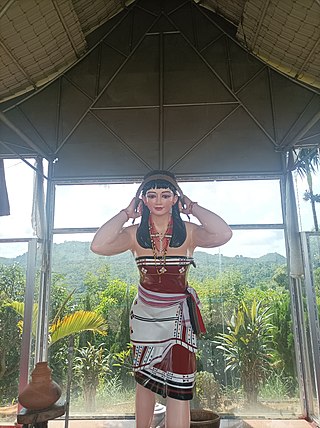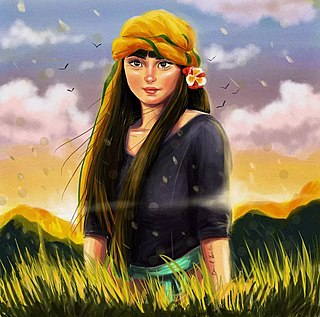
Panthoibi, also known as Nongpok Leima, is a goddess associated with civilization, courage, fertility, handicraft, love, victory, warfare and wisdom in the mythology and religion of Ancient Kangleipak. She is a consort of the God Nongpok Ningthou. She is considered to be one of the divine incarnations of Leimarel Sidabi and is also identified as a form of Goddess Nongthang Leima. She is worshipped mainly by the Meitei people in Manipur, Assam, Tripura, Bangladesh and Myanmar.

Irai Leima is a goddess in Sanamahism, the indigenous religion of Manipur. She is the goddess and the divine female personification of water and aquatic life. She is the consort of Irai Ningthou. Both are regarded as the divine spirits of water bodies. She is also considered to be in charge of diseases.

In Meitei mythology and religion, Nongthang Leima is the goddess of seduction, thunder, and lightning. She was created by Atingkok to attract Haraba (Pakhangba). She mastered thunder and lightning in the chaos in the early world. She predicted the first rain. She limits the chaos and helps creation.

Nongpok Ningthou, also known as the Sovereign of the East or King of the East, is a deity in Sanamahism, the indigenous religion of Manipur. He is the ruling guardian deity of the eastern direction. Legend says Nongpok Ningthou and his consort Panthoibi were united in the Nongmaiching Ching mountains. Later, they were worshipped as the civilization giving deities in Meitei religion.

Kounu is a goddess in Meitei mythology and Sanamahism, the indigenous religion of Manipur. She is a consort of the god Koupalu. She is the guardian of the northern direction. Kounu has two homes. Her main home is on Mount Kounu. Her other home is in Mount Koubru, which is where her husband Koupalu (Koubru) lives. She is worshipped with Koubru as the deities of the Khullakpa. Kounu and Koubru ruled ancient Manipur for a very long time after the reign of King Ningthou Puthiba.

Haoreima or Haoleima is a goddess of tragic love and separation in Meitei mythology and Sanamahism, the indigenous religion of Manipur.> According to some legends, she was a woman from the hills, who was killed while arranging to meet her lover, and turned into a tortured spirit. She is regarded as an incarnation of Goddess Panthoibi. She is also identified with the goddess Nongthang Leima.

Khoriphaba is a God in Sanamahism, the indigenous religion of Manipur. He is the son of Sky God Salailen and the Goddess Konthoujam Tampha Lairembi. He came down from heaven to earth to search for his mother and then for a bride. He is best known for wrestling with Loyalakpa in the Lai Haraoba festival. He is also a Sagol Kangjei(polo)-playing God.

Phouoibi or Phouleima is the goddess and the female personification of the agriculture, crops, fertility, grains, harvest, paddy, rice and wealth in Meitei mythology and religion of Ancient Kangleipak . She is the lover of Akongjamba, a hero in ancient legends. But fate does not permit the lovers to unite. So, Phouoibi and Akongjamba reincarnated in the legends. She was sent by Thangching to Moirang) kingdom to make the human world prosperous. The legends of her love with Akongjamba were believed to be enacted by Thangching as a part of the Moirang Saiyon legends.

Noinu Thumleima or Thumkhong Lairembi is the Meitei goddess of salt.

Yumjao Leima or Yumjao Lairembi or Yumjao Lairemma is the mother goddess of house, household, royalty, rule and power in Meitei mythology and religion. She is designated as the all time ruling Queen Mother. Legend says she assumes a human form in white clothes and blesses kings. She is one of the divine incarnations of Leimarel Sidabi.

Laikhurembi is a goddess in Sanamahism, the indigenous religion of Manipur. She is the goddess of justice, good counsel, divine law, order and secrecy. She is the chief Queen of God Thongaren . She is the daughter of Lairen Humchouba. She is one of the divine incarnations of Leimarel Sidabi. She is one of the most important Umang Lais. Her pantheon is maintained particularly by the Taibungjam clan of Meitei ethnicity.

Loyalakpa is a God in Sanamahism, the indigenous religion of Manipur. He is best known for wrestling with Khoriphaba during the Lai Haraoba festival. He is the consort of goddess Thoudu Nungthel Leima. He is one of the ten kingly gods in Meitei religion.

Thangching or Thangjing is a primordial deity in Sanamahism, the indigenous religion of Manipur. He is the ruling deity of the Moirang dynasty. He rules supreme on the banks of the landlocked sea, Loktak lake. He is one of the four cardinal Umang Lais. The guardianship of the south western direction is alluded to Thangjing and the other directions to Koubru, Marjing and Wangbren.

Khunu Leima or Khunureima is the goddess of pigeons and doves in Sanamahism' the indigenous religion of Manipur. She is a sister of goddesses Nganu Leima and Shapi Leima. Legend says that all three sisters married the same mortal man.

Nganu Leima is the goddess of ducks and waterfowl in Sanamahism, the indigenous religion of Manipur. She is a sister of goddesses Khunu Leima and Shapi Leima. Legend says that all three sisters married to the same mortal man.
Ucheks have significant roles in different elements of Meitei culture, including but not limited to Meitei cuisine, Meitei dances, Meitei festivals, Meitei folklore, Meitei folktales, Meitei literature, Meitei mythology, etc.

Women have significant roles in different elements of Meitei culture, including Meitei dances, Meitei festivals, Meitei folklore, Meitei folktales, Meitei literature, Meitei mythology, Meitei religion, etc.

The cultural heritages of Meitei civilization has classicism in diverse traditions of cinemas, dances, language, literature, music, theatre, etc.










